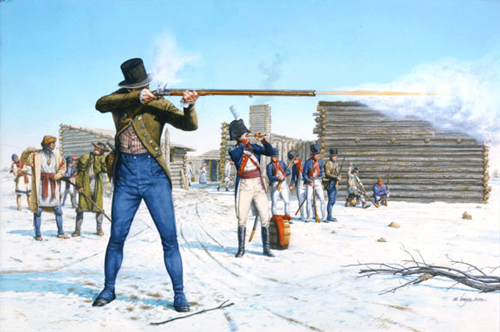Shooting for the Red Leggings
© Michael Haynes, https://www.mhaynesart.com. Used with permission.
On 16 January 1804, Clark staged a shooting contest between the soldiers and local citizens. Reubin Field was the best shot.
In the captains’ journals, the name was always “Reubin Fields,” but today we know the last name was “Field,” and—through recent research by Bob Moore, historian at Jefferson National Expansion Memorial—that he sometimes signed his name with the traditional spelling of “Reuben.” But in the Lewis and Clark world, “Reubin” he remains.
Reubin and his brother Joseph (about a year older) were among the best hunters, but Reubin was possibly the better shot. He was, at least, at Camp Dubois on 16 January 1804, when Clark’s men set up a shooting match with some local residents. At stake was a pair of leggings. Clark recorded that Reubin came in first, followed by “Wist” [Windsor, Wiser, or perhaps one of the locals], John Shields, then Robert Frazer. In a another contest two years later—this time against Nez Perce men at Long Camp on 8 June 1806—Lewis wrote that “several foot rarces [sic] were run this evening between the indians and our men. the indians are very active; one of them proved as fleet as Drewer and R. Fields, our swiftest runners.” Aside from these skills and attributes, the Field brothers, along with John Shields, were among the overall top hands after George Drouillard. (See details, and their commendation from the captains, under Joseph Field.) However, Reubin had some trouble getting used to military ways. At Camp Dubois during early March 1804, he refused Sgt. John Ordway‘s command to stand guard on regular rotation. Castigated by Lewis for “disorderly conduct,” Reubin repented, and never was in trouble again.
Although the brothers’ names are often written in tandem as “J. & R. Fields” throughout the journals, they did not invariably hunt together, but frequently were paired with other hunters. One of Reubin’s sub-specialties was making exploratory side trips up rivers that flowed into the Missouri: with Patrick Gass, up the White River in South Dakota on 15 September 1804 and 16 September 1804; up Red Water Creek (the captains’ “2000 Mile Creek”) in eastern Montana on 3 May 1805; and making the initial foray ahead on the Missouri River with Joseph on 3 June 1805, when the Corps reached the Marias River. The brothers hiked seven miles but did not find the waterfall that would confirm they were on the Missouri. After their report, the captains made up their two larger parties to go simultaneously up the Missouri and the Marias. After the falls were found and the arduous portage was in progress, Reubin was sent up the Sun River with Drouillard not only to hunt for meat, but also to bring back elk hides to cover the iron boat. As always, they took note of what else they saw. Clark recorded on 25 June 1805 that they said the Sun River was “120 yds wide about 8 feet deep[.] Some timber on its borders—.”
Genealogist Larry Morris speculates that Reubin and Joseph joined the 1807 civilian component of Chouteau fur men going up the Missouri, and that Joseph was killed in the Arikara battle that prevented Chief Sheheke‘s immediate return to his Mandan village, and cost George Shannon a leg. If so, that was the end of Reubin Field’s interest in the far frontier. After his brother’s death, however, Reubin turned his thoughts again to an army career. In St. Louis, he approached Clark and received a recommendation for a lieutenancy, but the down-sized peacetime army had no opening available.
The following year he married—or meant to. Apparently Reubin and Mary Myrtle were wed by an itinerant frontier minister, and later heard whispers about the man of the cloth’s credentials. Writing his will in 1822, Reubin made sure to protect Mary: “To wife Mary Field, forever, entire estate; should their marriage performed in Indiana in 1808 by one they thought was a minister of the Gospel named Smith, but later learned may not have been, be considered illegal, then he bequeathed to her as Mary Myrtle, her former name, said estate forever.”[1]Larry E. Morris, The Fate of the Corps: What Became of the Lewis and Clark Explorers After the Expedition (New Haven: Yale University Press, 2004), 155. Reubin died not long after writing his will, but in the meantime he and Mary, childless, moved to Jefferson County, Kentucky, and began to farm with the help of four slaves.
Notes
| ↑1 | Larry E. Morris, The Fate of the Corps: What Became of the Lewis and Clark Explorers After the Expedition (New Haven: Yale University Press, 2004), 155. |
|---|
Experience the Lewis and Clark Trail
The Lewis and Clark Trail Experience—our sister site at lewisandclark.travel—connects the world to people and places on the Lewis and Clark Trail.
Discover More
- The Lewis and Clark Expedition: Day by Day by Gary E. Moulton (University of Nebraska Press, 2018). The story in prose, 14 May 1804–23 September 1806.
- The Lewis and Clark Journals: An American Epic of Discovery (abridged) by Gary E. Moulton (University of Nebraska Press, 2003). Selected journal excerpts, 14 May 1804–23 September 1806.
- The Lewis and Clark Journals. by Gary E. Moulton (University of Nebraska Press, 1983–2001). The complete story in 13 volumes.


